Oldsmobile Achieva 1995 Owner's Manuals
Manufacturer: OLDSMOBILE, Model Year: 1995, Model line: Achieva, Model: Oldsmobile Achieva 1995Pages: 340, PDF Size: 16.99 MB
Page 201 of 340
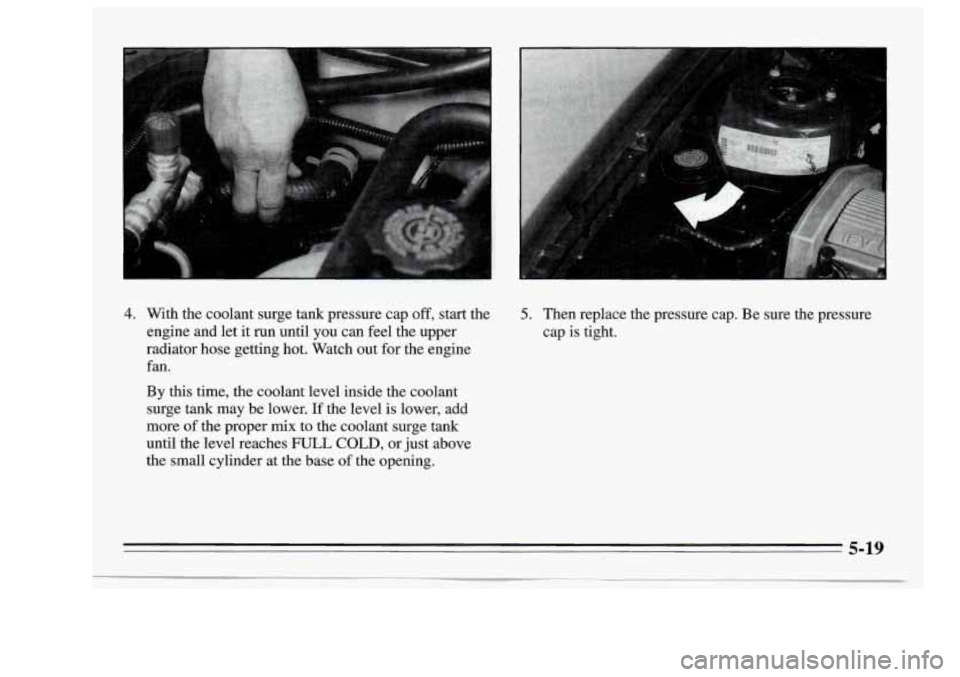
4. With the coolant surge tank pressure cap off, start the
engine and let it run until
you can feel the upper
radiator hose getting hot. Watch out for the engine
fan.
By
this time, the coolant level inside the coolant
surge tank may be lower.
If the level is lower, add
more of the proper
mix to the coolant surge tank
until the level reaches
FULL COLD, or just above
the small cylinder at the base
of the opening.
5. Then replace the pressure cap. Be sure the pressure
cap is tight.
5-19
Page 202 of 340
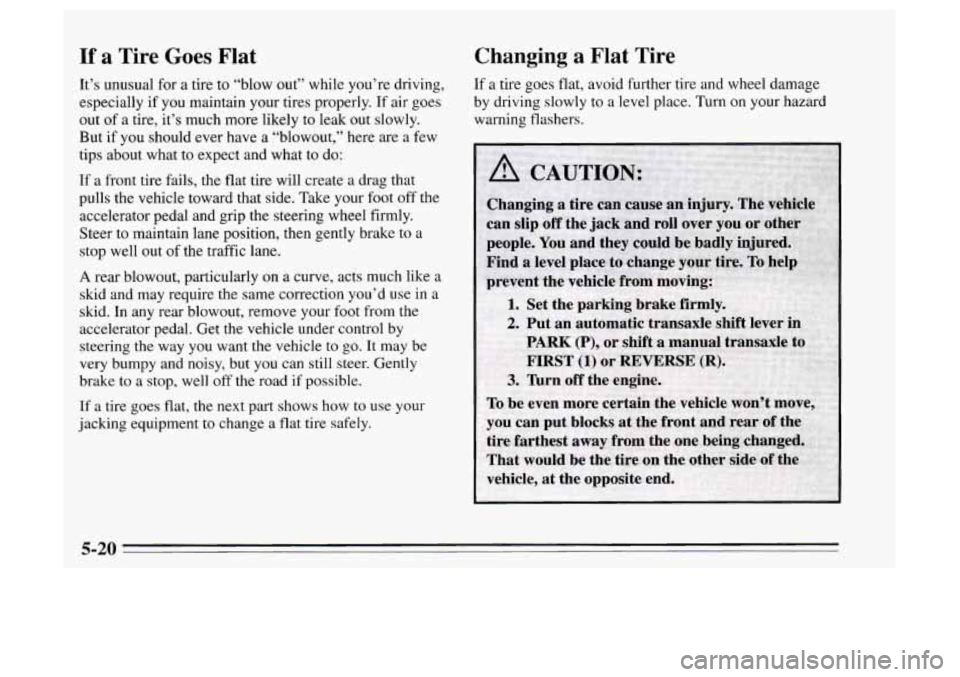
If a Tire Goes Flat
It’s unusual for a tire to “blow out” while you’re driving,
especially if you maintain your tires properly. If air goes
out of a tire, it’s much more likely to leak out slowly.
But if you should ever have a “blowout,” here are a few
tips about what
to expect and what to do:
If a front tire fails, the flat tire will create a drag that
pulls the vehicle toward that side. Take your foot off the
accelerator pedal and grip the steering wheel firmly.
Steer to maintain lane position, then gently brake to a
stop well out of the traffic lane.
A rear blowout, particularly on a curve, acts much like a
skid and may require the same correction you’d use
in a
skid. In any rear blowout, remove your foot from the
accelerator pedal. Get the vehicle under control by
steering the way you want
the vehicle to go. It may be
very bumpy and noisy, but you can still steer. Gently
brake to a stop, well off the road if possible.
If a tire goes flat, the next part shows how
to use your
jacking equipment to change a flat tire safely.
Changing a Flat Tire
If a tire goes flat, avoid further tire and wheel damage
by driving slowly to a level place. Turn on your hazard
warning flashers.
5-20
-
Page 203 of 340
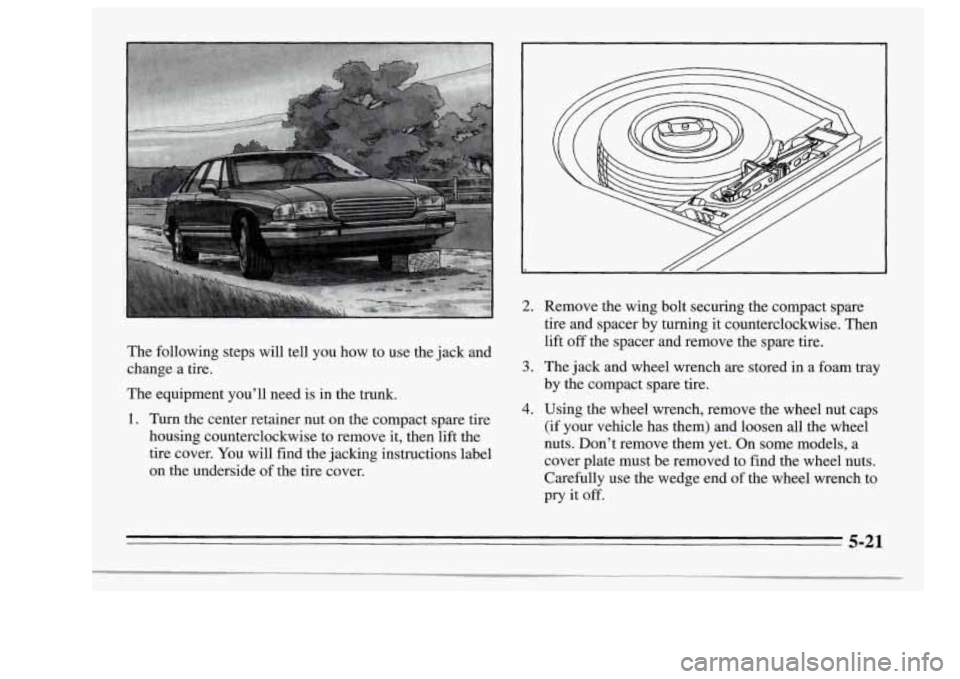
The following steps will tell you how to use the jack and
change a tire.
The equipment you’ll need is in the trunk.
1. Turn the center retainer nut on the compact spare tire
housing counterclockwise to remove it, then lift the
tire cover.
You will find the jacking instructions label
on the underside of the tire cover.
2. Remove the wing bolt securing the compact spare
tire and spacer by turning it counterclockwise. Then
lift
off the spacer and remove the spare tire.
3. The jack and wheel wrench are stored in a foam tray
by the compact spare tire.
4. Using the wheel wrench, remove the wheel nut caps
(if your vehicle has them) and loosen all the wheel
nuts. Don’t remove them yet. On some models, a
cover plate must be removed to find the wheel nuts.
Carefully use the wedge end of the wheel wrench to
pry it
off.
5-21
Page 204 of 340
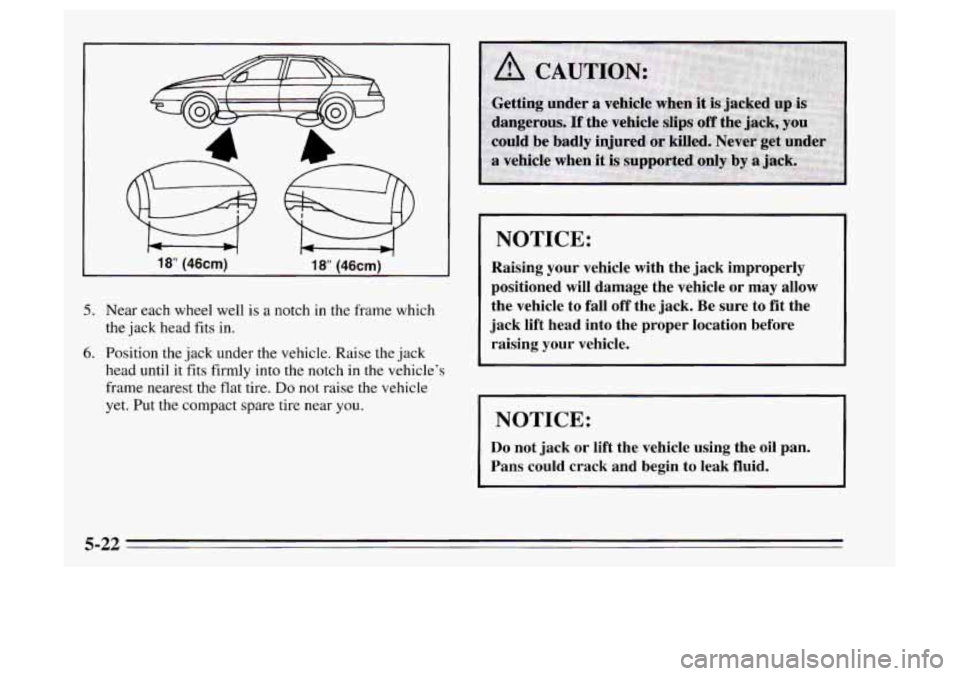
I 18 (46cm) 1 8” (46cm)
5.
6.
Near each wheel well is a notch in the frame which
the jack head fits in.
Position the jack under
the vehicle. Raise the jack
head
until it fits firmly into the notch in the vehicle’s
frame nearest the
flat tire. Do not raise the vehicle
yet. Put the compact spare tire near you.
I NOTICE:
Raising your vehicle with the jack improperly
positioned will damage the vehicle or may allow
the vehicle to fall off the jack. Be sure to fit the
jack lift head into the proper location before
raising your vehicle.
NOTICE:
Do not jack or lift the vehicle using the oil pan.
Pans could crack and begin to leak fluid.
5-22
Page 205 of 340
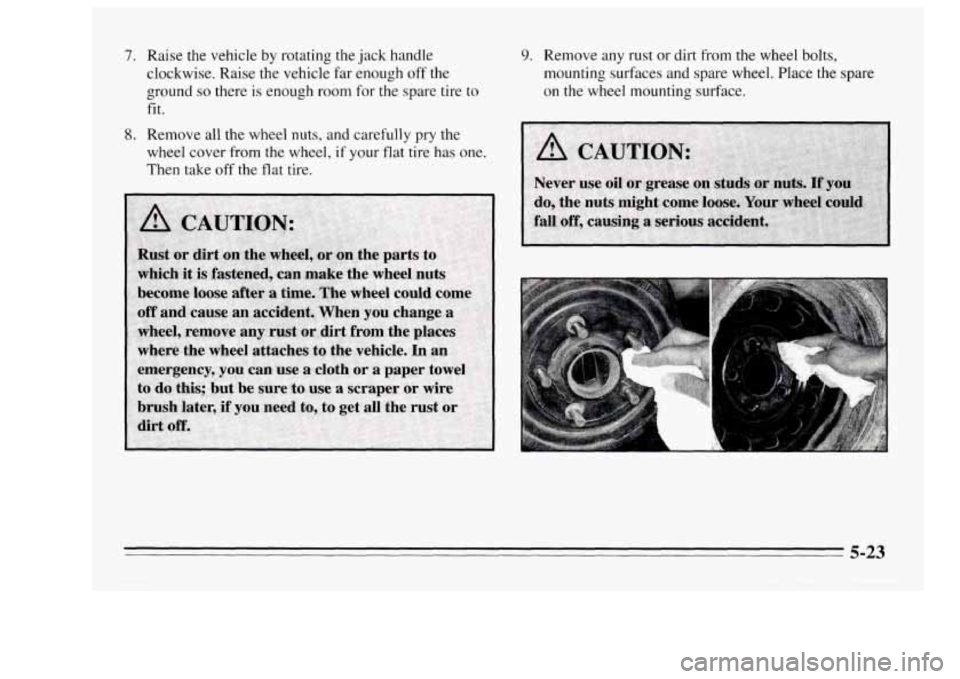
7.
8.
Raise the vehicle by rotating the jack handle
clockwise. Raise the vehicle
far enough off the
ground
so there is enough room for the spare tire to
fit.
Remove all the wheel nuts, and carefully pry the
wheel cover from the wheel, if your flat tire has one.
Then take
off the flat tire.
9. Kernove any rust or dirt from the wheel bolts,
mounting surfaces and spare wheel. Place the spare
on the wheel mounting surface.
5-23
Page 206 of 340
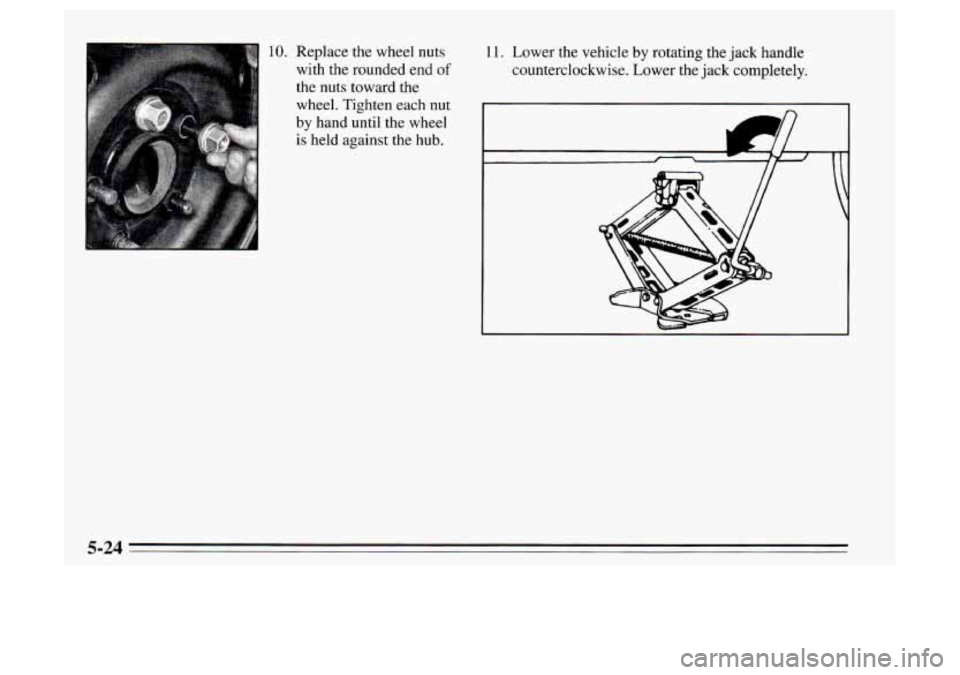
10. Replace the wheel nuts
with the rounded end
of
the nuts toward the
wheel. Tighten each nut
by hand until the wheel
is held against the hub. 11.
Lower the vehicle
by rotating the jack handle
counterclockwise. Lower the jack completely.
I
I
5-24
Page 207 of 340

- 12. Tighten the wheel nuts
firmly in a criss-cross
sequence, as shown. Don’t
try to put a wheel cover on your compact spare
tire.
It won’t fit. Store the wheel cover and wheel nut
caps in the trunk until you have the flat tire repaired
or
replaced.
FNOTICE:
Wheel covers won’t fit on your compact spare. If
you try to put a wheel cover on your compact
spare,
you could damage the cover or the spare.
5-25
Page 208 of 340
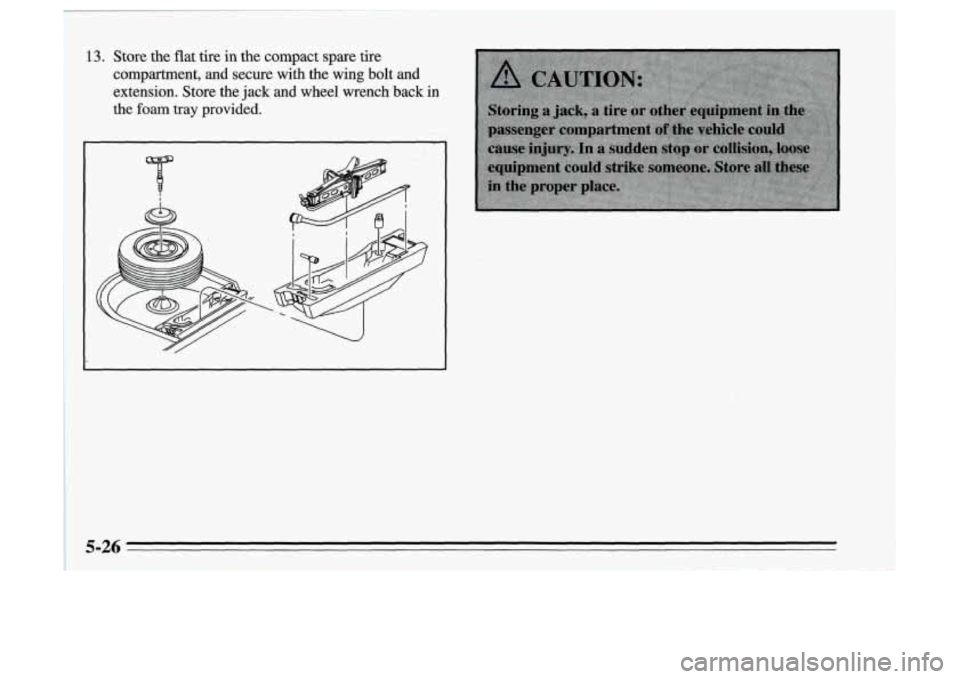
13. Store the flat tire in the compact spare tire
compartment, and
secure with the wing bolt and
extension. Store the jack and wheel wrench back in
the foam tray provided.
5-26
Page 209 of 340
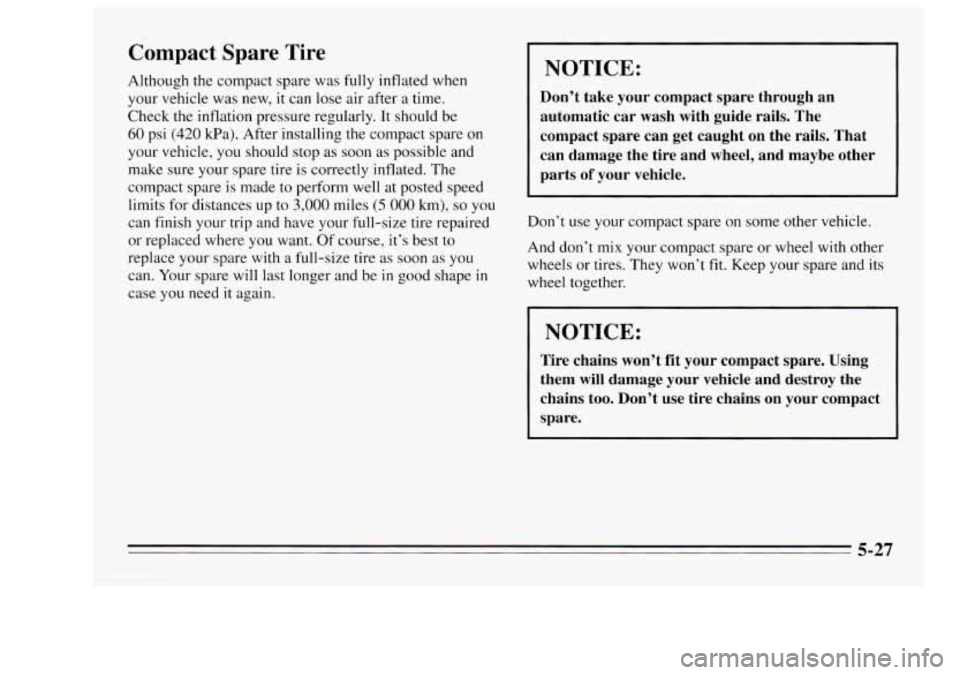
Compact Spare Tire
Although the compact spare was fully inflated when
your vehicle was new, it can lose air after a time.
Check the inflation pressure regularly. It should be
60 psi (420 kPa). After installing the compact spare on
your vehicle, you should stop as soon as possible and
make sure your spare tire
is correctly inflated. The
compact spare is made to perform well at posted speed
limits for distances up to
3,000 miles (5 000 km), so you
can finish your trip and have your full-size tire repaired
or replaced where you want. Of course, it’s best to
replace your spare with a full-size tire as soon as you
can. Your spare will last longer and be in good shape
in
case you need it again.
I NOTICE:
Don’t take your compact spare through an
automatic car wash with guide rails. The
compact spare can get caught on the rails. That
can damage the tire and wheel, and maybe other
parts
of your vehicle.
Don’t use your compact spare on some other vehicle.
And don’t mix your compact spare or wheel with other
wheels or tires. They won’t fit. Keep your spare and its
wheel together.
NOTICE:
Tire chains won’t fit your compact spare. Using
them will damage your vehicle and destroy the
chains
too. Don’t use tire chains on your compact
spare.
Page 210 of 340
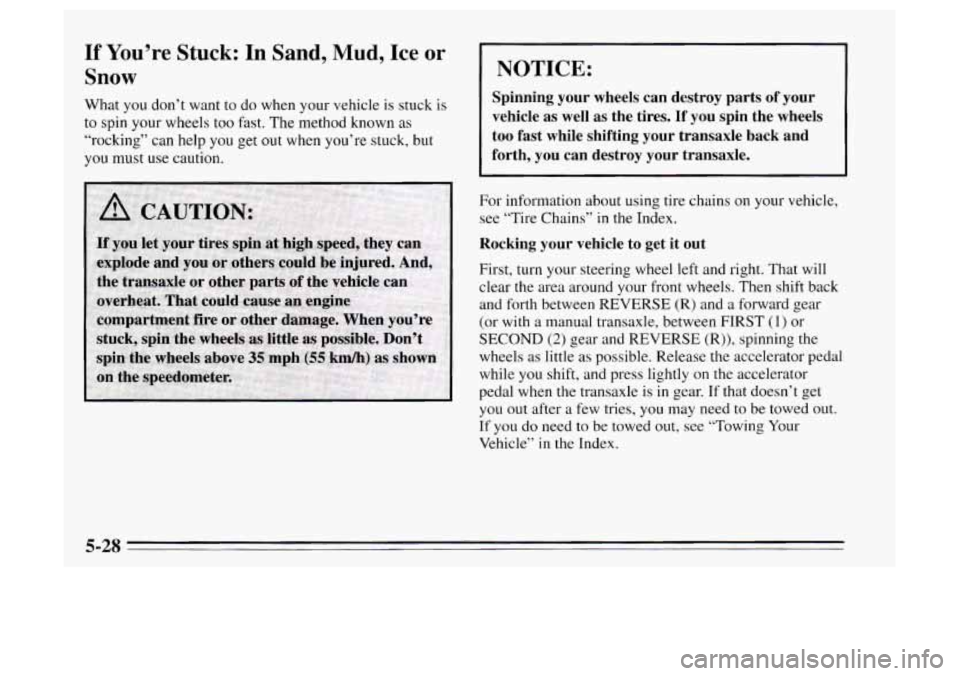
If You’re Stuck: In Sand, Mud, Ice or
Snow
What you don’t want to do when your vehicle is stuck is
to spin your wheels too fast. The method known
as
“rocking” can help you get out when you’re stuck, but
you must use caution.
NOTICE:
Spinning your wheels can destroy parts of your
vehicle as well
as the tires. If you spin the wheels
too fast while shifting your transaxle back and
forth, you can destroy your transaxle.
For information about using tire chains on your vehicle,
see “Tire Chains”
in the Index.
Rocking your vehicle to get it out
First, turn your steering wheel left and right. That will
clear the
area around your front wheels. Then shift back
and forth between REVERSE
(R) and a forward gear
(or
with a manual transaxle, between FIRST (1) or
SECOND (2) gear and REVERSE (R)), spinning the
wheels as little as possible. Release the accelerator pedal
while you shift, and press lightly on the accelerator
pedal when the transaxle is in gear. If that doesn’t get
you out after a few tries,
you may need to be towed out.
If
you do need to be towed out, see “Towing Your
Vehicle”
in the Index.
5-28